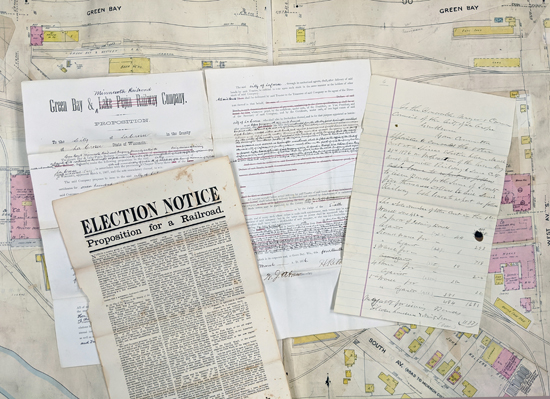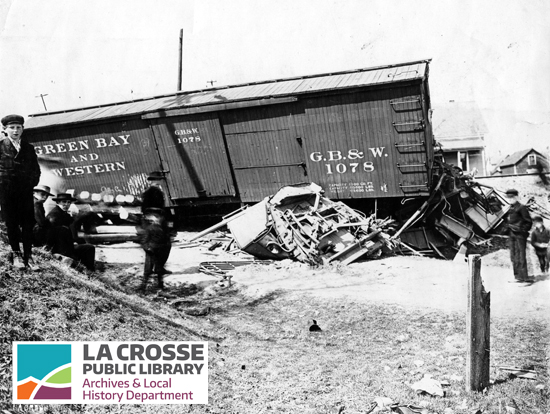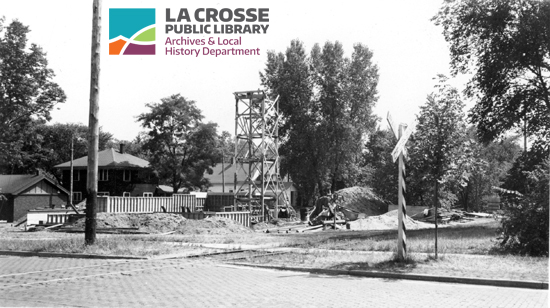
The Green Bay & Western Railroad Legacy
(written by Anita Taylor Doering, Archives staff)
As early as 1873, La Crosse city officials approached the Green Bay line, then known as the Green Bay and Lake Pepin Railroad, to try and lure another railroad company to service La Crosse for freight and passenger service and break the monopoly that the Chicago, Milwaukee and St. Paul Railroad (CM&StP) had on the city.
By 1876, a compromise was reached, whereby La Crosse would be a branch railroad of the Green Bay & Minnesota Railroad, starting from the Marshland Junction via the La Crosse, Trempealeau and Prescott Railroad through a lease agreement to their Onalaska station, then lay their own tracks to La Crosse.

A closeup of the Green Bay Route territory map of 1908, highlighting in purple the route of roughly 28 miles from the Marshland Junction in Trempealeau County south to the city of La Crosse. From the La Crosse Series 32 La Crosse, Wisconsin, Committee on Railroads, Resolutions and Reports Relating to Railroads, 1858-1932 held by the La Crosse Public Library Archives
Behind the scenes deals were already in place between the Green Bay railroad and the Chicago and Northwestern, arch rival of the CM&StP, to form a partnership as a way for both lines to get into La Crosse and cross over the existing railroad tracks.
Knowing that the tracks would come into La Crosse from the north, the proposal presented to La Crosse residents also stipulated that the branch would go “south of Main Street, and a convenient and commodious depot building erected within such limits, and regular passenger and freight trains are running between such depot and the eastern terminus of the main line of Company.…”
City council approached voters in a special election on March 21 requesting authorization to sell bonds of $75,000 to pay for it (or $1.8 million in today’s money). The proposal passed by a large margin, 1681 affirmative and 484 negative.

Original documents from the proposal of the Green Bay & Minnesota Railroad, March 1876, all laying on top of the Sanborn Fire Insurance Map showing the Green Bay depot and yard. From the La Crosse Series 32 La Crosse, Wisconsin, Committee on Railroads, Resolutions and Reports Relating to Railroads, 1858-1932 held by the La Crosse Public Library Archives
Construction on the line began right away and the first regular train road the rails on September 25, 1876. GB&W track was the first that crossed with the CM&StP in North La Crosse. This became known as Grand Crossing and would eventually serve five separate railroad lines at this crossroads at one time.
The line continued south over wetlands on trestles that were filled in later years and entered La Crosse where the State Teachers College would be built. The eastern part of the city was sparsely populated at this time so the tracks were laid on streets that would become 18th Street and East Avenue South on La Crosse’s South Side. It then curved sharply west just to the south of what became Green Bay Street so named for the rail line, terminating near the tracks of the Chicago, Burlington & Quincy and La Crosse & Southeastern, and opposite the Southern Minnesota’s terminal in La Crescent, Minnesota. The GB&W also owned property west of the terminal, giving the line an opportunity to build a bridge over the Mississippi River at some future point.

1898 City Atlas plate 4 with the Green Bay & Western Railroad track highlighted in purple
The first GB&W depot was shared with the C&NW at 9th and Green Bay streets and it consisted of a freight house, passenger building and train shed. Eventually the C&NW built its own line into the city from the north and establishing its own downtown depot in 1886, thus ending the shared line with the GB&W on the eastern side of the city. In 1903, the GB&W built a new frame depot at 904 Green Bay Street. The depot was razed in 1973.

Scene near East Avenue and Market Street on April 21, 1908, when a streetcar collided with a Green Bay & Western work train
When railroad trains traverse cities and more densely populated areas, more accidents occur. On April 21, 1908, Frank Werner, motorman for the street car company, failed to yield to an approaching Green Bay & Western work train that were destined to reach the railroad crossing near 18th and Market streets at the same time.
According to a website Green Bay Route, much of the traffic on the La Crosse Branch was coal deliveries. Once construction was completed by 1909, the college also became dependent on the coal supplies the GB&W brought literally to the college’s heating plant.
Another regular coal customer was the Myrick Park Pumping Station, the city’s water pumping station that was constructed in 1912 to replace the original pumphouse on King Street. Just north of the pumping station is the La Crosse River marsh.
The third large coal customer was the gas and electric company. For the period from 1914-1920, the most important commodities hauled on the line to and from La Crosse in terms of tonnage were coal, brick and stone, merchandise, beer, lumber, grain, empty kegs, and iron and steel. Salzer Seed was a large customer as well and shipped out seed on the very first and the very last GB&W run on the branch. A seed warehouse was near the depot and train yard.
The branch line was never very profitable, and because of the expensive lease agreement to use the C&NW tracks, the branch lost money. Also, the C&NW limited the GB&W branch to one mixed freight-passenger train a day on their tracks. Eventually the GB&W made an agreement with the Chicago, Burlington & Quincy (CB&Q) to serve those few remaining coal delivery customers and left La Crosse for good on October 26, 1922. However, the GB&W held on to its property and right-of-way (r-o-w) in La Crosse until July 1936. It was sold to the CB&Q for $27,000.
In 1959, the CB&Q sold the former GB&W property to the city. What is now the University of Wisconsin-La Crosse was experiencing tremendous student enrollment after World War II and part of the r-o-w was sold to them. The other former railroad r-o-w was used mainly for streets and many alleys were opened.

The Sons of Abraham Synagogue at 1820 Main Street under construction, circa 1947. Notice that Main Street has brick pavers and that the Green Bay & Western crossing here is uncontrolled. Where the tracks were located is now a north-south alley. Photograph taken by Gordon Feinberg.
Directly north of the city pumping station is the La Crosse River marsh, also called Myrick Marsh. The former Green Bay & Western track embankments along with raised dike roads to city water wells in the marsh became part of the Myrick marsh RABBIT (River and Bluff Bicentennial Intra-City Trail) hiking trails constructed in 1976. The La Crosse River Marsh water wells were used by the city of La Crosse from 1912 – 1969.

